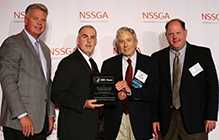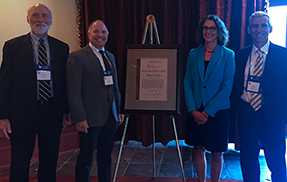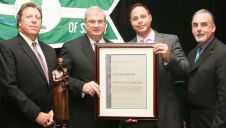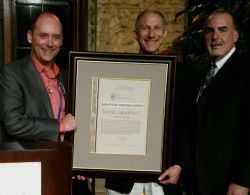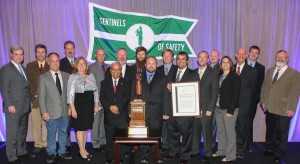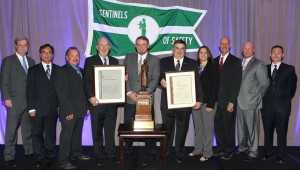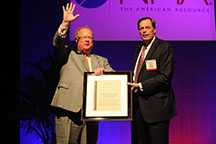NIOSH Mine Safety and Health Technology Innovations Award
The NIOSH Mine Safety and Health Technology Innovations Award recognizes mines and companies that have made an extraordinary effort to apply technology or improve processes in innovative ways, above and beyond mandatory requirements, to improve mine worker safety and health.
In mining, technology should not be a one-time “fix” but rather an evolving and continuously improving process of applying new and better technologies and systems to solve problems. To recognize these safety milestones, NIOSH created the Technology Innovations Award with the goal of promoting technology identification, adoption, and dissemination throughout the mining industry. Mines and companies that qualify are invited to self-apply.
How to Apply
The nomination process is simple. Send an email to the Associate Director for Mining answering these questions:
- What problem were you solving?
- What is the technology or process and how does it work?
- How did you modify and evaluate the technology or process to solve your specific problem?
- What did you do to implement the technology or process at your mine?
- What health and safety benefits have been realized or are expected?
Specify which industry sector (metal, coal, industrial minerals, or stone, sand & gravel) is most applicable to your submission.
Also include the name of the mining operation or company implementing the technology or process improvement and the name, email address, and phone number of the primary contact for the submission.
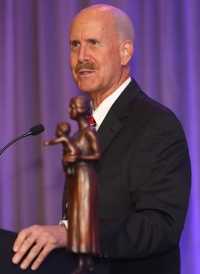
Dr. John Howard presents the 2014 NIOSH Mine Safety and Health Technology Innovations Awards.
Pictures and diagrams are optional, but may be submitted to help us understand the technology. The submission does not need to be elaborately produced and the text can be in layman’s terms. If further clarification is needed during the review process, NIOSH will contact the submitters.
When we receive your nomination we will send you an acknowledgement and additional information on what to expect during the evaluation process.
Although nominations will be accepted throughout the year, please note that awards are given annually and the award date will correspond to the meeting date for the sponsoring organization. In order to allow time for full consideration of each nomination, nominations must be received no later than the listed deadline. Nominations received after the deadline will automatically be considered for an award in the subsequent year.
| Sector | Award Venue | Nomination Deadline | Meeting Date |
|---|---|---|---|
| Stone, Sand, and Gravel | NSSGA Legislative & Policy Forum/Fall Board Meeting | July 31, 2017 | Sept. 2017 |
| Metal | NMA Safety Award Ceremony | August 1, 2017 | Nov. 6, 2017 |
| Coal | NMA Safety Award Ceremony | August 1, 2017 | Nov. 6, 2017 |
| Industrial Minerals | IMA-NA Annual Meeting | June 30, 2018 | Sept. 2018 |
For questions, email us at mining@cdc.gov, or call 412-386-5302.
2017 Award Winners
Health and Wellness Program (Stone, Sand & Gravel Sector)
Fitness for duty can be negatively affected if a company's workforce struggles with numerous health challenges. Granite Mountain Quarries and Pine Bluff Sand & Gravel Company began a health and wellness program for employees and their spouses in order to address a growing concern that worker health might compromise the safety of the job site. The multi-operation company rewarded healthy habits and healthy behavior through cash and HRA contributions. Many employees lost weight and stopped smoking. About half of employees now regularly get annual physicals, and many of those employees have either begun taking medications to address previously unknown issues, or been able to stop taking medication due to weight loss and better health habits. The company reports that their workforce now reports to work energetic, alert, and ready to concentrate on the task at hand.
2016 Award Winners
Fan Hanging Machine (Metal Sector)
Hanging auxiliary fans in underground metal mines is a difficult and potentially hazardous job, as the fans are large and the equipment currently used to lift them into place does not provide a safe location for workers away from the suspended load. Small Mine Development, LLC, and JH Fletcher together developed a purpose-built fan hanging machine to protect mine workers from the potential hazards of working around a large, suspended load. This machine securely holds the fan and has a platform for miners that travels up with the fan and moves independently along the length of the fan.
Stockpile Safety System (Coal Sector)
The safety of workers who operate dozers on surface stockpiles at mines depends on knowing where feeder locations are, and if material is feeding properly from above operating feeders. Arch Coal, Inc.’s Leer Mine developed a stockpile safety system to enhance dozer operator awareness and to help eliminate stockpile dozer incidents. The system offers video to the dozer operator and the plant operator of the dozer's location on the stockpile in relation to the feeders. An audible warning is provided if the dozer enters a zone above the feeder. In addition, the operators can confirm via video that the coal is being pulled from the surface of the stockpile to indicate there are not any voids. This system represents a significant advance to enhance dozer operator awareness to help eliminate future stockpile dozer incidents.
Dry Scrubbing System (Industrial Minerals Sector)
Airborne dust generated when ore is handled or transported can be a health hazard for mine workers. Focusing on the conveyor transfer point as a significant airborne dust contributor, Tronox Alkali developed a dry scrubber system that separates the dust particles from the air and uses an automated compressed air pulse system to clean the filters. The removed dust is collected in a hopper where it is mixed with water and then pumped to a mining sump. The system has been very effective and the company plans to have a second system operational soon.
2015 Award Winners
Compressed Air Foam Fire Suppression System (Coal Sector)
A fire in an underground coal mine can spread quickly, threatening the lives of every worker in the mine. Rapid suppression of the fire is often the best way to prevent disaster. Working with RM Wilson Company and Red Dog Services, Murray Energy Corporation developed a rail car-mounted compressed air foam fire suppression system to fight fires that can occur when transporting combustible material out of the mine. This system consists of a Red Dog Services Suppressor 60 modified to be mounted on an underground rail car with 500 feet of fire hose. Murray Energy worked with its partners to develop, refine, and test the system for effectiveness and durability. They have deployed 20 systems through seven of their operating companies.
Helmet-CAM Technology (Industrial Minerals Sector)
Workers' exposure to respirable dust containing crystalline silica has long been a concern for the health of our nation’s workers. Unimin Corporation worked in cooperation with NIOSH to field test and evaluate the Helmet-CAM technology. The Helmet-CAM technology integrates a wearable video recorder with a real-time data-logging aerosol monitor for the effective and efficient assessment and identification of work areas and processes that impact a worker’s personal respirable dust exposure. Unimin implemented the Helmet-CAM technology at about 40 of its operations, requiring each production facility to conduct two Helmet-CAM studies annually to identify opportunities to further control exposures or to evaluate controls.
2014 Award Winners
An Integrated Approach to Real Time Data Analysis for Changing Ground Conditions (Metal Sector)
The safety of miners in open pit operations is highly dependent on understanding changing ground conditions using data from numerous types of sensing technologies. To implement its vision of a safety based geomechanical program, Freeport–McMoRan has embraced existing and emerging technologies and has created active partnerships with various data collection, information systems and technical providers. Through this cooperative effort, a system was developed that consolidates large sets of raw and processed data from many data streams, can produce early alarms based on movement outside of predicted trends, and analyze ground behavior to provide geomechanicial engineers timely and accurate notifications to support appropriate actions. Importantly, this integrated approach to real time data analysis and automated alarms represents the next big step in safety improvements that can be applied to many different surface and underground mining operations.
An Innovative Technology Solution to Improve Safety during Longwall Recovery Operations (Coal Sector)
Coal miners can be exposed to many hazards during the difficult process of a longwall recovery. JENNMAR, and its engineering affiliate company, Keystone Mining Services, working together with Signal Peak Energy personnel, developed and demonstrated a successful method to greatly reduce the exposure of miners to hazardous conditions during this process. This method made longwall recovery history by successfully mining into a 42-foot wide, full-face recovery entry that was first bolted, meshed, and then completely back-filled with a specially formulated, cuttable, low density concrete that was pumped from the surface. As a result of the coordination and cooperation between JENNMAR and Signal Peak, an innovative use of this technology was developed resulting in improved safety during longwall recovery operations.
Remote Loader Operation (Stone, Sand, and Gravel sector)
Luck Stone modified a CAT 988G pit loader so it could be operated either remotely or from the cab, which reduced the risk of injuries during certain hazardous operations. The CAT 988G uses an electro-hydraulic system, which means that electronic controls in the cab feed a computer with information that controls the hydraulic valves on the machine. To bypass the machine's computer and allow an operator to control the machine outside of the cab, Luck Stone installed a supplemental processor which can take commands from a wireless remote control. A toggle switch on the processor allows an operator the option of controlling the machine in the cab or at a safe distance. The remote capability permits an operator to control many of the machine's functions, including the boom lift circuit, the bucket rack back and dump circuit, the engine's RPMs, the engine's emergency shut-down, and the transmission's forward, reverse, and neutral gear selection. With this innovation, Luck Stone provided its workers with a way to take the hazard out of many hazardous operations.
2013 Award Winners
A Collision Avoidance System to Improve Mine Access and Haul Road Safety (Metal Sector)
The risks of travel on mine access and haul roads significantly increase during darkness, fog, and other adverse weather conditions. Collision avoidance under limited visibility conditions is a challenging problem, and the aviation industry has reduced accidents through the application of traffic-awareness technologies. Hecla's Greens Creek Mine, working with SAFEmine Technology USA, adapted a GPS and radio technology approach first used for aircraft collision avoidance. The resulting peer-to-peer communication system is simple and robust, providing vehicle operators with improved situational awareness and voice-annunciated warnings when potential collisions develop.
Next-Generation Sensors for Atmospheric Monitoring Systems (Coal Sector)
The potential for atmospheric monitoring systems to improve mine safety is limited by commercially available sensors that can be deployed throughout underground coal mines. Alpha Natural Resources partnered with Matrix Design Group to design, develop, and commercialize improved air velocity, low-power methane, and flexible-use carbon monoxide sensors, with wireless and wired data transfer options. The intrinsically safe approval with the 24-hour battery backup provides post-accident functionality for these sensors in addition to their day-to-day use to improve mine safety by detecting potentially harmful developments in the mine's ventilation network.
Clothes Cleaning Booth Technology (Industrial Minerals Sector)
Contaminated work clothing represents a potentially significant area of respirable dust exposure for workers at industrial minerals operations. Unimin Corporation, working in cooperation with NIOSH, developed a clothes cleaning booth technology. This technology provides a quick, safe, and highly effective method that allows workers to clean their dust-soiled clothing periodically throughout the workday. This system safely captures the dust and contaminants from the worker’s clothing and removes them so as to not further expose the worker, co-workers, or the work environment. This technological innovation has been commercialized and put into practice at multiple work sites.
2012 Award Winners
The inaugural awards, which highlighted coal and metal/nonmetal mining, were presented on September 25, 2012, during MINExpo at the ceremony for the National Mining Association Sentinels of Safety Awards. These awards, initiated in 1925, are given annually to the nation’s safest mines.
The National Mining Association provided framed certificates for the 2012 winners:
Freeport-McMoRan Copper & Gold received the award for adapting an Australian over-the-road fatigue monitoring system for use in mine haul trucks and for implementing practices to use the information provided by the system to prevent accidents in the surface mining environment.
Lockheed Martin was recognized for developing a two-way, through-the-earth (TTE) mine communication system, known as MagneLink®, to aid in the rescue of underground mine workers in a post-accident environment. The system provides two-way voice and text communication from deep underground mines to the surface.
CONSOL Energy was honored for its commitment and collaboration to improve post-accident communications and for interfacing Lockheed Martin’s TTE technology with the company’s primary communications system. This could expand mine workers’ options for post-accident communications and possibly expedite the development and commercialization of TTE technology. The MagneLink® system was installed at CONSOL’s Robinson Run mine in West Virginia in November 2011 to evaluate its capability in an operational mine.
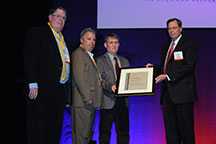
Mark Somers, Warren Gross, and Tom Parks of Lockheed Martin accept the award from Jeff Kohler of NIOSH.
Background: The Challenge of Applying Technologies in Mining
The Sago Mine disaster in 2006 illuminated the critical role that technology needs to play to allow for mine worker escape and rescue in a post-accident environment. The ensuing discussions, Congressional hearings, and the NMA’s Mine Safety Technology and Training Commission revealed inadequacies in the development and adoption of technologies that could improve mine safety, especially in the areas of emergency communications and tracking, refuge alternatives, and oxygen supply. The reasons for these inadequacies are many, and Congress correctly pinpointed a key barrier: The market for technology products in mining is so small that it is difficult to recover the costs for research and development, or even the ordinary costs associated with commercializing a new technology. Further compounding the problem, technology products approved under international standards and used in mines in other countries cannot be used in the United States unless they have been approved by the Mine Safety and Health Administration (MSHA). The costs associated with the approval process are often considered greater than the potential U.S. market for the product. In practical terms, this has kept some technologies from the U.S. market.
Congress addressed this “small market” problem and codified the importance of mine safety technology in the Mine Improvement and New Emergency Response Act (MINER Act) of 2006. In the MINER Act, NIOSH was charged with developing existing and new technologies related to oxygen supply, refuge chambers, and communications and tracking. NIOSH has met this challenge in partnership with the mining industry, labor unions, manufacturers, the international mining community, and other Federal agencies including MSHA, the National Aeronautics and Space Administration (NASA), the National Institute of Standards and Technology (NIST), and the Naval Research Laboratory. As a result, our nation’s mines are now populated with a suite of post-accident communications and tracking technologies, many of which were developed through the NIOSH programs established by the MINER Act.
See Also
- The Modern Evolution of Hearing Conservation Regulations
- New National Survey of the U.S. Mining Population Published
- Refuge Chamber Training Products and Guidance
- Review of Recent Research on Organizational and Behavioral Factors Associated With Mine Safety
- Significant Dust Dispersion Models for Mining Operations
- Teaching Miners: Breaking the Barriers to Learning
- Technology News 511 - NIOSH Develops Improved Mining Safety and Health Web Topic Page
- This Is Mining...
- Wire Rope Research: Analysis of Bending Fatigue in a 2-Inch IWRC Wire Rope
- Work Sampling Applied to a Human Factors Analysis of Mine Worker Positioning
- Page last reviewed: 10/13/2017
- Page last updated: 9/25/2017
- Content source: National Institute for Occupational Safety and Health, Mining Program


 ShareCompartir
ShareCompartir
